
Giovanni Bellini was an Italian Renaissance painter, probably the best known of the Bellini family of Venetian painters. He was raised in the household of Jacopo Bellini, formerly thought to have been his father, but now that familial generational relationship is questioned. An older brother, Gentile Bellini was more highly regarded than Giovanni during his lifetime, but the reverse is true today. His brother-in-law was Andrea Mantegna.

Lorenzo Lotto was an Italian painter, draughtsman, and illustrator, traditionally placed in the Venetian school, though much of his career was spent in other north Italian cities. He painted mainly altarpieces, religious subjects and portraits. He was active during the High Renaissance and the first half of the Mannerist period, but his work maintained a generally similar High Renaissance style throughout his career, although his nervous and eccentric posings and distortions represented a transitional stage to the Florentine and Roman Mannerists.

Vittore Carpaccio (UK: /kɑːrˈpætʃ oʊ/, US: /-ˈpɑːtʃ-/, Italian: [vitˈtoːre karˈpattʃo]; was an Italian painter of the Venetian school who studied under Gentile Bellini. Carpaccio was largely influenced by the style of the early Italian Renaissance painter Antonello da Messina, as well as Early Netherlandish painting. Although often compared to his mentor Gentile Bellini, Vittore Carpaccio's command of perspective, precise attention to architectural detail, themes of death, and use of bold color differentiated him from other Italian Renaissance artists. Many of his works display the religious themes and cross-cultural elements of art at the time; his portrayal of St. Augustine in His Study from 1502, reflects the popularity of collecting "exotic" and highly desired objects from different cultures.

BartolomeoMontagna was an Italian Renaissance painter who mainly worked in Vicenza. He also produced works in Venice, Verona, and Padua. He is most famous for his many Madonnas and his works are known for their soft figures and depiction of eccentric marble architecture. He is considered to be heavily influenced by Giovanni Bellini, in whose workshop he might have worked around 1470. Benedetto Montagna, a productive engraver, was his son and pupil and active until about 1540. He was mentioned in Vasari's Lives as a student of Andrea Mantegna but this is widely contested by art historians.
Andrea Solari (1460–1524) was an Italian Renaissance painter of the Milanese school. He was initially named Andre del Gobbo, but more confusingly as Andrea del Bartolo a name shared with two other Italian painters, the 14th-century Siennese Andrea di Bartolo, and the 15th-century Florentine Andrea di Bartolo.

Giovanni Battista Cima, also called Cima da Conegliano, was an Italian Renaissance painter, who mostly worked in Venice. He can be considered part of the Venetian school, though he was also influenced by Antonello da Messina, in the emphasis he gives to landscape backgrounds and the tranquil atmosphere of his works. Once formed his style did not change greatly. He mostly painted religious subjects, often on a small scale for homes rather than churches, but also a few, mostly small, mythological ones.

Marco Basaiti was a Venetian painter of the Renaissance who worked mainly in Venice and was a contemporary of Giovanni Bellini and Cima da Conegliano. He has been referred to by several names including Marco Baxaiti, Marcus Basitus, and Marcus Baxiti. There is little documentation on Marco Basaiti besides his painting signatures and a guild's ledger of 1530 that records him as a painter of figures.

St. Francis in Ecstasy is a painting by Italian Renaissance master Giovanni Bellini, started in 1475 and completed around 1480. Bellini depicted the religious figure of St. Francis of Assisi in a landscape. In 1852, the painting was listed on June 19 at Christie's. It was part of the 1857 Manchester Art Treasures exhibition. In 1915, Henry Clay Frick bought the painting for $170,000, and it remains in the Frick Collection, in New York City.
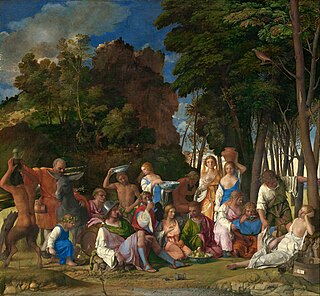
The Feast of the Gods is an oil painting by the Italian Renaissance master Giovanni Bellini, with substantial additions in stages to the left and center landscape by Dosso Dossi and Titian. It is one of the few mythological pictures by the Venetian artist. Completed in 1514, it was his last major work. It is now in the National Gallery of Art in Washington D.C., which calls it "one of the greatest Renaissance paintings in the United States".

Venetian painting was a major force in Italian Renaissance painting and beyond. Beginning with the work of Giovanni Bellini and his brother Gentile Bellini and their workshops, the major artists of the Venetian school included Giorgione, Titian, Tintoretto (1518–1594), Paolo Veronese (1528–1588) and Jacopo Bassano (1510–1592) and his sons. Considered to give primacy to colour over line, the tradition of the Venetian school contrasted with the Mannerism prevalent in the rest of Italy. The Venetian style exerted great influence upon the subsequent development of Western painting.
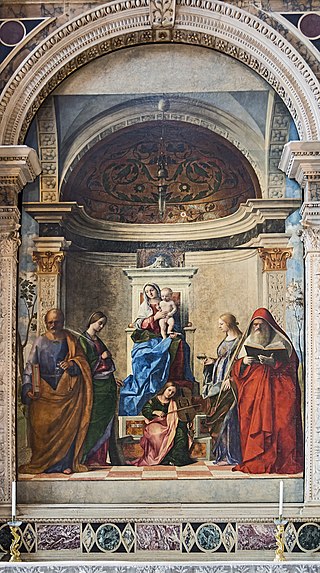
The San Zaccaria Altarpiece is a painting by the Italian Renaissance painter Giovanni Bellini, executed in 1505 and located in the church of San Zaccaria, Venice.
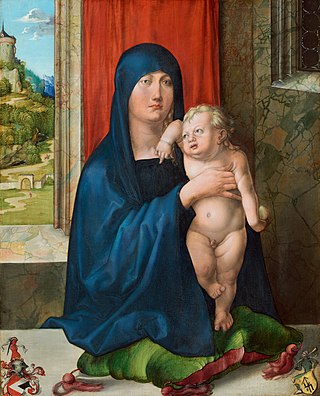
The Haller Madonna is an oil painting by Albrecht Dürer, dating to between 1496 and 1499. It is now in the National Gallery of Art, Washington, DC. The reverse also contains a full Dürer painting, entitled Lot and His Daughters.
Saint Jerome in the Wilderness or Saint Jerome in the Desert is a common subject in art depicting Saint Jerome. In practice the same subject is often given titles such as Saint Jerome in Penitence and Saint Jerome Praying. Well-known versions usually given a "wilderness" or "desert" title include:

St. Mark Preaching in Alexandria is an oil painting by the Italian Renaissance artists Gentile and Giovanni Bellini, dated to 1504–1507, and held in the Pinacoteca di Brera, in Milan.
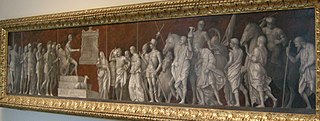
The Continence of Scipio or An Episode from the Life of Publius Cornelius Scipio is a painting in oils on canvas by Giovanni Bellini, dating to 1507–08 and now in the National Gallery of Art in Washington, D.C.

St. Jerome in the Desert or St. Jerome Reading in the Desert is a 1480 oil on panel painting by Giovanni Bellini, now in the Uffizi Gallery in Florence as part of the Contini Bonacossi collection, giving it its alternative title of The Contini Bonacossi St. Jerome.

The Pesaro Altarpiece is an oil-on-panel painting by the Italian artist Giovanni Bellini, dated to some time between 1471 and 1483. It is considered one of Bellini's first mature works, though there are doubts on its dating and on who commissioned it. The work's technique is not only an early use of oils but also of blue smalt, a by-product of the glass industry. It had already been used in the Low Countries in Bouts' 1455 The Entombment, but this marked smalt's first use in Italian art, twenty years before Leonardo da Vinci used it in Ludovico il Moro's apartments in Milan in 1492. Bellini also uses the more traditional lapis lazuli and azurite for other blues in the work.
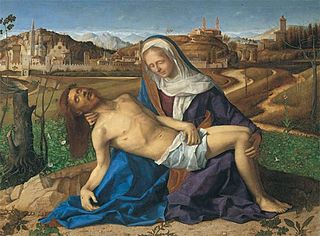
The Martinengo Pietà is an oil painting on panel of c. 1505 by Giovanni Bellini, signed on the rock to the left of the Virgin. It was previously in the collections of the Martinengo family and of Donà delle Rose and is now in the Gallerie dell'Accademia in Venice.
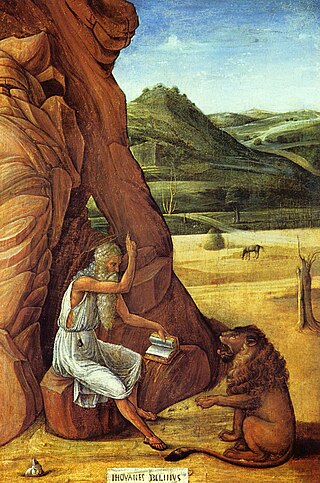
St. Jerome in the Desert is a c. 1450 egg tempera painting on wood by the Italian Renaissance artist Giovanni Bellini, now in the Barber Institute of Fine Arts in Birmingham, England.

















